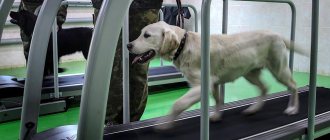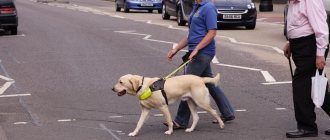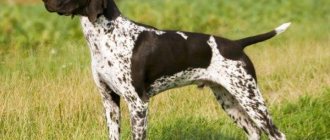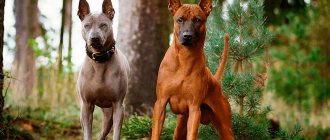A guide dog, or, as experts in this field say, a guide dog, is an unconditional assistant for a visually impaired person , helping him to move outside the confines of an apartment or house with the greatest possible safety. The main task of such a dog is to guide the owner along the road, choose the safest trajectory and warn about all obstacles along the way. Obstacles include concrete vehicle barriers, fences, stairs, ledges or steps, low tree branches or low-hanging wires, traffic lights, trenches, etc. and so on. At these and any other obstacles, the dog stops and waits until its owner, using a white cane, examines the object and understands what it is and how to get around it. And only after the person gives the command, the animal continues to move.
In everyday speech, the variant “guide dog” is much more common, but from the point of view of professionals, these animals are called “guide dogs”. Therefore, if you are talking to experts, it is better to choose a more formal wording.
Guide dogs are taught to walk half a length ahead of the owner, and he leads her on a special harness with a rigid arc , which allows him to better feel the pet. However, this is only a small part of what guides are taught. In Russia, several specialized centers are engaged in their preparation. One of the most famous is located near Moscow - in the Kupavna microdistrict of the city of Balashikha. The full name of this is (RSHPSP VOS). Another large center for guide dogs is located in the same Balashikha, but in Zheleznodorozhny - this is a training and cynological center (a shorter version is “Assistance Dogs”).
Using the examples of these schools, we propose to consider how guide dogs are trained. Of course, the training programs are similar in many ways, because similar requirements are imposed on guides.
The first book on training guide dogs was published back in 1819. However, the most active development of this area occurred in the post-war period - to help those who lost their sight in battles. In Europe this is the First World War, in the USSR it is the Great Patriotic War.
When were dogs first used as guide dogs?
Guide dogs for the blind and visually impaired have an impressive history that began in Germany during World War I, where service dogs first helped veterans who had lost their sight in combat. Guide dogs came to prominence in 1927 when an American dog breeder, Dorothy Harrison Eustis, wrote an article about guide dogs for the Saturday Evening Post. Her article inspired a visually impaired American named Morris Frank.
Frank visited Switzerland and trained Buddy, one of Eustis's dogs, there. After that, Frank and Buddy returned back to the United States, where they made a big tour demonstrating the abilities of guide dogs. Their public appearances showed the need for service dogs to have access to shops, restaurants, hotels, public transport and other places where they were previously denied access. They also founded the first guide dog school in America.
Peculiarities
Important skills of guide dogs and requirements for them In ordinary life, a guide is an ordinary dog that loves the affection of its owner, games, walks, and treats.
However, during working hours - when the animal is leading its owner - its behavior must meet strictly defined criteria:
- The guide must be able to not be distracted by anything. Whether a cat or another dog is passing on the street, whether firecrackers are exploding or cars are making noise, dogs for blind people leading their owners must concentrate as much as possible on the road. Of course, the animal is not a robot and can get distracted, but a good guide returns to its main duties at the first signal from the owner. When training, special attention is paid to ensuring that the dog is not afraid of the bustle and noise of big cities. To do this, for example, with still young animals they walk quite a lot along busy streets.
- A dog should not protect a person - its functions are completely different. The fact is that a guard dog may not allow doctors or other strangers to approach the owner, while blind people may need the help of other people. Therefore, guides are taught not to protect, but to accompany.
- The dog must perfectly remember routes: to the store, to the clinic, to work, etc. The best option is if sighted relatives or loved ones of a blind person introduce the animals’ routes. For a well-prepared guide, 2-3 passages are enough to remember the road for a long time and be able to reproduce it even after a long break. Usually the owner gives the route a name, and it becomes a command for the guide.
- The dog must be prepared for the peculiarities of moving with a blind owner. For example, examining an obstacle for a blind person may take some time, and the guide must patiently stand and wait for the command to continue moving. The conductor also needs to know all the typical situations that he may encounter while accompanying the owner, including when traveling on public transport. To practice these cases, the school in Kupavna has an old bus.
In addition, the dog must be sociable, love its owner, and strive to help him. Philanthropy is a very important trait of guides. Without this, they will not be able to truly care for a blind person according to their needs. Physical characteristics are also important - the conductor must be healthy, hardy, able to tolerate movement in transport, etc.
Some disabled people who already have a dog ask for it to be raised as a guide dog. However, in most cases this is not possible.
Volunteering for schools
Schools welcome volunteer work. Usually this means that those who wish can take on the first and second stages of training, and then the guide dog training center will focus only on the special course (third stage). For example, the center in Kupavna accepts donations or purchases dogs worth up to 10 thousand rubles . The main selection criteria are that the character, bearing and abilities of the animals meet the same requirements that apply to other pupils. In other words, a dog that gets along easily with a person, is trainable, well-mannered, is not afraid of loud sounds, etc. is considered suitable.
A dog is selected for each person individually, taking into account both character compatibility and other aspects, for example, the height and weight of the animal - so that the owner can comfortably walk with his pet and care for it.
The RSHPSV VOS is ready to take in Eastern European and German shepherds, Labradors and golden retrievers up to two years old. Of course, the animal must be healthy, but compliance with traditional breed standards in this case is not at all important.
In turn, the school in Zheleznodorozhny organized work with volunteers according to a different scheme. actively involved here, who raise puppies already selected by the center from 2-3 months to a year , after which the animals return to school and move on to a special course. The breeds of dogs for future transfer to the blind or for use in the rehabilitation of children are the same here - mainly golden retrievers and Labradors.
If necessary, volunteers are provided with food and all dog household items ; in addition, specialists from the center visit them regularly (usually weekly), including to conduct special classes with the puppies. The main task of the foster family is to take care of the animal, socialize it, and teach it basic commands. The school's curators and veterinarians are ready to provide any advice and assistance, be it advice on raising or fostering an animal during a volunteer's vacation.
After the allotted time has passed, the puppy will definitely need to be returned for further training, but the ex-teacher will be able to find out about the fate of the dog: whether it has completed a special course, whether it has found an owner, how it is living, etc. The center emphasizes that keeping a future guide dog is not only a socially responsible job, but also, for example, a kind of training for those who are thinking about getting a dog, but are not yet sure that they can cope with caring for it.
What breeds are suitable as guide dogs?
It so happens that the best breeds of guide dogs for the blind are considered to be Labradors, Shepherds, Collies, Rottweilers, Dobermans and others. In fact, the breed is not the key factor, since the dog must meet a number of other equally important characteristics. Its physical characteristics are also important, because the animal must be the right size for its owner.
German Shepherd
The dog has unique intellectual abilities; it can learn commands quickly and in large quantities - learning them will only require a few repetitions. The animal's intelligence goes well with loyalty, a kind and cheerful disposition. Thanks to their natural courage, shepherd dogs are used as watchdogs and rescuers: for example, they come to the aid of water disasters, fires, and to search for those lost in the mountains. It is important that the animal shows kindness and affection not only to the owner, but also to the children. The dog is also tolerant of other animals. However, trainers and dog handlers note that now shepherd dogs are less often used as guide dogs, since the breed has become more sporting and exhibition.
Collie
Like all herding breeds, collies have a genetically strong instinct to protect their owner, as well as small children. They are distinguished by their good disposition, activity, and devotion. This breed is especially often trained as a guide dog for children. The main advantages of this breed: lack of fear of street noise and busy traffic; quick orientation even in unfamiliar terrain; the ability to subtly sense the needs and desires of its owner.
Labrador
If you describe the character of a dog in one word, then “friend” refers specifically to this breed. The Labrador is very prudent, calm, and easy to train. The average height of the dog reaches 56 cm, which facilitates comfortable movement on the street. According to statistics, 80% of people with visual impairments choose this breed as a guide. For small children, such a dog can replace a nanny. The Labrador responsibly fulfills the tasks assigned to it. The lifespan of a dog is from 12 to 18 years.
- Dog
- Long-eared cats
- Cat meowing
- Alexandrian parrot
- Why does a cat need a mustache?
- Rescue dogs
Golden Retriever
The dog's character is very friendly and flexible. The breed has proven itself to be good companions, children's favorites, and helpers. Dogs can often be found in police or customs service due to their keen sense of smell. The Ray Retriever is a smart dog, quickly remembers all commands, is trainable, hardy and flexible. This breed is suitable for the role of a guide dog or water rescuer. On average, the Golden Retriever lives up to 15 years.
Rottweiler
The Rottweiler dog breed is the most loyal, strong, and resilient. Thanks to its physical characteristics, it can serve as a guide, guard, or rescuer. Externally, the dog is very large, with a wide chest and neck, height from 60 cm to 70 cm. Very smart, trainable. Such a dog needs a strong-willed mentor or owner. Because of his manic devotion and jealousy, he can harm others. It is recommended that the animal be taken outside on a leash and muzzle.
Doberman
It is better to purchase such a dog as a guide dog for a child. The Doberman is a kind of perpetual motion machine. You need to play and walk with him a lot. Children will be very happy with its constant mobility. He will fit very harmoniously into any family, becoming its full-fledged member. By nature, they are very calm, approach strangers with caution, and quickly determine whether their charges are in danger.
Dobermans are able to adapt to their owner's mood. During the game, they can remember any commands and carry them out with precision in the shortest possible time. Such dogs grow up to 72 cm and weigh up to 50 kg.
Boxer
If Boxer dogs are properly raised and trained, they become excellent rescuers and guide dogs. Animals are very friendly towards others, if you do not set them up in an aggressive direction. They will always come to the rescue if they feel a threat to the owner’s life.
Based on the structure of their body, dogs are suitable for people of short stature, disabled people, as well as children. They do most of the work at home, which is suitable for people with disabilities. All commands are easily understood, they are quickly remembered, and their further execution occurs automatically, even without a reminder. The dog is small in size. Its height reaches up to 57 cm, weight – up to 45 kg.
Giant Schnauzer
At first glance, it is difficult to imagine such a giant as a guide. The dog's height is from 60 cm to 70 cm, and its weight is 50 kg. But Giant Schnauzer dogs are strong, brave and resilient. They have a well-developed sense of protection. In any situation they will come to the defense of the owner.
These dogs are very hardworking and patient. The main difference between the Schnauzer and other dog breeds is its phenomenal memory. Dog experts say that this is the smartest dog breed. Animals will become ideal companions for blind people, and will also brighten up the gray days of your children.
Royal Poodle
The list would be incomplete without the Royal Poodle. Kind and unpretentious, he is ready to serve his master until his last breath. Poodles are easy to care for and train, so they are suitable even for inexperienced owners. It is impossible to get bored with this dog: the poodle will support any game and will happily meet family friends. But, if the owner needs help, this dog will do everything possible to make him happy.
Obstacles and their bypass
It seems impossible to teach this to a dog. After all, the task of the guide is to inspect the entire space around the blind person and warn him in time about the danger. Moreover, there are obstacles that are absolutely not significant for a dog, but are important for a person. These could be various branches, wires, canopies or small holes. The dog's task is to prevent any obstacle from colliding with the blind man.
Training is carried out in ordinary courtyards or streets, where there are a variety of obstacles at different heights. Here the dog handler will use the already familiar commands - “Stop” and “Fu”. How to explain everything to your pet? The dog handler takes a cane, the kind that blind people usually use, and moves around the site. When an obstacle is detected, an already learned command sounds, requiring you to stop. And then the trainer knocks on the obstacle with a stick, explaining to the dog why the stop occurred.
The guide must respond to these movements. If there is no reaction, then the person forcibly turns the dog. And a dog that completed the task and led its owner through the obstacles unharmed should be rewarded with treats and praise.
How are guide dogs trained?
Any person, including the blind, has a certain route of movement along which he follows from home to work, to the store, for a walk and back home. The guide must study this route well so that the blind can move, confidently relying on his “fellow traveler.”
During training, dogs are taught to perform the following commands:
- moving in front of the owner, making turns. Training for these teams takes place at a training ground with a variety of paths. The animal is taught to walk calmly and stop at the first request of the owner. To do this, the dog handler, playing the role of a blind man, suddenly stops while walking and gives the command to the dog to “stand!” over time, guides in such situations stop moving, even if they do not find any obstacles in front of them that require stopping.
- stopping movement in front of an obstacle and going around it. This indispensable skill should be in the arsenal of every guide dog. She is required to: stop in front of an obstacle, notify her owner about it, and also prevent possible obstacles that are not significant for the dog, but can cause discomfort or even be dangerous for a blind person (for example, canopies at the entrance to a store, wires, low trees and etc.)
To teach the animal these skills, the trainer uses the commands “stand!” and “ugh!” For training, ordinary areas are used (yard, playground or street), on which obstacles of all shapes and sizes are placed in different orders. A dog handler with a cane for the blind moves around a training ground prepared in advance. If an obstacle appears in his path, the command “stand!” is given, and the trainer hits the obstacle with the cane several times. If there is no response to the command, the dog handler repeats it again and forcibly guides the dog using a leash.
Benches, boards, pipes, barrels, and crossbars at different heights can act as obstacles. When the dog successfully completed the task and led its owner near the obstacle, it should be praised in every possible way and encouraged with treats.
- passage between objects placed close to each other. After the animal has mastered the previous command, you can begin training this skill, which occurs in a similar way: when the dog handler approaches the obstacle, he begins to tap on it with a stick and forces the dog to bend around.
- going up and down stairs. These skills are taught using the commands “go!” and “quiet!” When the dog steps onto the first step of the stairs, the trainer says “quiet!” and knocks a little on the steps with a stick, then to resume movement he gives the command “forward!”, and so on at every step. In a similar way, the guide is trained to move over uneven surfaces such as ravines or hills.
- driving a blind person on city streets and on a set trajectory. When mastering this skill, a dog becomes simply indispensable for a blind owner in an urban environment. To teach it, the trainer uses the commands “Quiet!”, “Forward!” etc., as well as the names of certain places: “Home”, “Shop”, “Park”, etc. The conductor must literally master the rules of the road - be able to cross the street depending on traffic lights, move on the right side of the sidewalk at a distance from the roadway.
Movements and turns
To teach these commands, dog handlers have special training grounds with many paths. Dogs are led along them and taught to walk at an absolutely calm pace, and also to stop in time. The dog must stop moving at the first request of the owner. For this purpose, the dog handler pronounces the phrase “Stop” and abruptly freezes in place. The guide's task is to immediately complete the task.
The development of such an instinct occurs over time. The dog stops under any circumstances, even if he does not see the need for it.
Getting a dog used to a permanent owner
Those few weeks that last the third stage of training a guide dog - handing over the trained animal to the owner - are a very important period for both of them. It is at this stage that it will become clear whether the dog and the person are suitable for each other.
A guide dog is trained to drive a person over several months (usually about eight). The person did not receive such preliminary preparation. And, using the help of specialists, he is still often forced to act in relations with his guide on a whim. After all, the dog handler at this stage accompanies the dog and the person, but is not close to them, but follows the couple at some distance.
The owner should spend as much time as possible with his four-legged guide. Use praise, offer treats in case of some success, talk to the dog more often, accustoming it to the sounds of your voice. There are cases when the owner and the dog do not suit each other, but they are extremely rare.
Trainer mistakes
Some dog handlers allow themselves to treat the animal roughly and demand that it execute commands through violence.
You cannot praise a pet if it shows aggression towards various animals and people it meets. And some trainers practice such rewards.
Many people want to train one dog as soon as possible so they can start working with another. This cannot be done. All commands must be taught consistently and efficiently. Practice every movement and every sound, because someone’s health and even life depends on it.
During training, you need to use clearly visible obstacles that would immediately attract the attention of the guide.
How much does a guide dog cost in Russia?
There is only one nursery school in Russia for raising such dogs. It opened in 1960. It was located in Moscow (Veshnyaki), then moved to the small village of Kupavna, where it still operates. There is also a private guide dog center. It operates in Moscow and exists solely on charitable contributions. The training is very labor-intensive and lengthy (12-15 months), costs 250 thousand rubles . For training, puppies 4–6 months old or young dogs receptive to training are purchased. After training, they are given to families for socialization, and then undergo additional training.
Guide dogs are provided to blind people free of charge. But you need to stand in line to receive it for about a year... The average price in Russia reaches 10 thousand dollars. Therefore, only 3–5% of the blind population of Russia can afford a guide. In European countries, four-legged assistants are provided for 50–80% of people with disabilities. The largest number of trained dogs live in the UK.
In Europe and the USA there is no special selection for blood purity. Border Collies, Bernese Mountain Dogs and almost all herding dogs are trained to be guide dogs. In fact, the only important requirement is height. The dog wears a special harness with a handle that the owner holds onto.
Collie
Another kind and smart breed. The main task for a collie is to protect its owner, especially if it is a child. She puts human safety first and only then thinks about her own health. In ancient times, these were shepherds' assistants who guarded the livestock. And now they are used as guards. But as a guide dog, collies can be found more often with small children.
Interesting Facts
Guide dogs can also serve as guards. People often even envy blind people when they see a dog next to them. It seems that this animal not only helps its owner, but also protects him. In fact, puppies that show even the slightest signs of aggression are not accepted into guide school. The fact is that a blind person often has to come into contact with strangers, turning to them for help. An aggressive animal may want to protect its owner and scare away or attack a stranger, sensing a threat in him. You should not want to see in such a friend not only an assistant, but also a security guard. Let it perform one function, but efficiently.
Guide dogs guide their owners across the road. This is a very popular misconception. But a guide dog does not lead its owner across the road based on the traffic light signal. The animal is trained to lead a person to a crossing and stop near a familiar landmark or near the side of the road. In general, there is an opinion that dogs are color blind. In any case, they perceive colors differently than we do. Therefore, you cannot require them to react to one or another traffic light signal. The decision about how to cross the road and when should be made by the person. And there are several solutions. Some blind people try to hear the approach of a car, while others ask passers-by for help.
The most determined ones put their hand with a cane forward and begin to move. It’s good if the crossings are safe and equipped with sound signals. After making a decision to cross the road, the person gives the command to the dog: “Forward!” And the animal begins to lead the owner across the road. Often ordinary people try to help a blind person in such a situation, but there is no need to attract the dog’s additional attention. You should not talk to her, lure her with food, stroke her, or try to flirt. We need to help a blind man, not entertain his assistant.
Video
Availability
Guide Dog Israel
Despite regulations or rules prohibiting access to animals in restaurants and other public places, in many countries service animals are protected by law and therefore can accompany their handlers in most places open to the public. Laws and regulations vary around the world:
- In the United States, the Americans with Disabilities Act prohibits any business, government agency, or other organization that provides access to the general public from prohibiting the use of service animals unless their presence would pose a health or safety risk. However, religious organizations are not required to provide such access. Whether service animals in training have the same rights or not is usually up to each state government. In addition, the Fair Housing Act requires that landlords allow tenants to have service animals, as well as other types of service animals, in residential buildings that generally have
a no-pet
policy and that such tenants cannot be charged additional fees. The Department of Housing and Urban Development's Office of Fair Housing and Equal Opportunity investigates complaints from the public alleging denials of reasonable accommodation requests related to animal assistance. - In the United Kingdom, the Equality Act 2010 provides that disabled people have the same right to services provided by shops, banks, hotels, libraries, pubs, taxis and restaurants as everyone else. Providers to accommodate service animals and service animal owners. Under Part 12 EA, it is illegal for service animal owners to deny access to a taxi or mini-cab with their service animal, but medical benefits are available if drivers have a certificate from their GPs.
- In most South American countries and Mexico, access to service animals depends solely on the goodwill of the owner or manager. In areas with a lot of tourists, service animals are usually accepted without problems. In Brazil, however, a 2006 federal decree requires that service animals be allowed in all public places. Metro Brasília has developed a program that trains service animals to ride on it.
- In Malta, the Equal Opportunities Act 2000 (Cap. 413) states that it is unlawful to discriminate against a person with a disability who requires an assistant, in this case a service animal. The exceptions are restaurant kitchens, special hospital rooms, toilets and rooms where other animals are kept.
- In Australia, the Disability Discrimination Act 1992 protects service animal owners. Each state and territory has its own laws, which may vary slightly.
- In Canada, service animals are allowed wherever the general public is permitted. Service Animal Laws by Province: Alberta: Blind Rights Act, Service Dog Act
- British Columbia: Guide Animal Act
- Manitoba: Human Rights Code, Service Animal Protection Act
- New Brunswick: Human Rights Act
- Newfoundland and Labrador: Blind Rights Act, Human Rights Act
- Northwest Territories: Human Rights Act
- Nova Scotia: Blind People's Rights Act, Human Rights Act
- Nunavut: Human Rights Act
- Ontario: Blind People's Rights Act, Accessibility for Ontarians with Disabilities Act, Human Rights Code
- Prince Edward Island: Human Rights Act
- Quebec: Persons with Disabilities Act, Charter of Human Rights and Freedoms
- Saskatchewan: Human Rights Code
- Yukon: Human Rights Act
Breeds suitable for the role of guides
In order to become a guide, a dog must have certain character traits. But in reality, in practice you can understand which dogs are guide dogs and which are not.
For the most part, large, hardy breeds are easier to train than other animals.
The best guide dogs are animals with the following character traits:
- Resourcefulness and intelligence.
- Restrained character, the ability to restrain innate abilities.
- Resistance to stress.
- Excellent eyesight and sense of smell.
- Loyalty to the owner.
Labrador
These are friendly, easy to train animals and are considered the best guide dogs. Due to their characteristics, it will not be difficult for them to switch from the instructor to the owner and establish a connection with him.
- This is a companion animal and has good stress resistance.
- Labradors are brave and friendly.
- They are very calm, and most blind people choose them.
- In addition to all these qualities, they have good health and live up to 18 years.
- This breed exhibits virtually no hostility; they communicate well with adults and children.
The training of these animals takes place effortlessly, up to about one and a half years. Another advantage of Labradors is their ideal size, thanks to which it will be easy for the owner to hold on to the harness.
German Shepherd
This breed is distinguished by good mental abilities and loyalty.
- Their intelligence and tenacity make them well suited for the role of a guide dog, and their courage makes them good guard dogs.
- Their resilience helps them work in even the coldest conditions, but unlike Labradors, they need more time to bond with their new owner.
An indispensable assistant
The help that these devoted animals provide to people with disabilities (in particular, the blind) is priceless. Very often, blind people lose contact with society and become confined within their usual space. Life seems uninteresting to them. However, the moment they receive a guide dog, radical changes occur in their lives: it begins a new round, the joy of discovery comes from visiting new unknown places.
The day when such a wonderful friend appears in their destiny will forever be imprinted on their lives. From now on, their life will always be divided into two parts:
- The world before the dog. This is a space limited by walls, familiar down to the centimeter, and going beyond the limits of which is incredibly scary.
- After the appearance of a guide dog. Life plays with new colors. A feeling of completeness arises, thanks to the devotion and humanity of the smartest animal.
For blind people, a guide dog becomes their eyes. The breed for such work is selected depending on the intelligence and compassion on the part of the animal.
Rottweiler
In the past, when Labradors were not so popular as guide dogs, Rottweilers were often used.
- In addition to loyalty, they have courage and perseverance.
- They need serious training and education, thanks to which they make excellent guide dogs.
- In addition to guides, they are excellent guards.
- These dogs are suitable for people with a strong character, as they may tend to be dominant.











